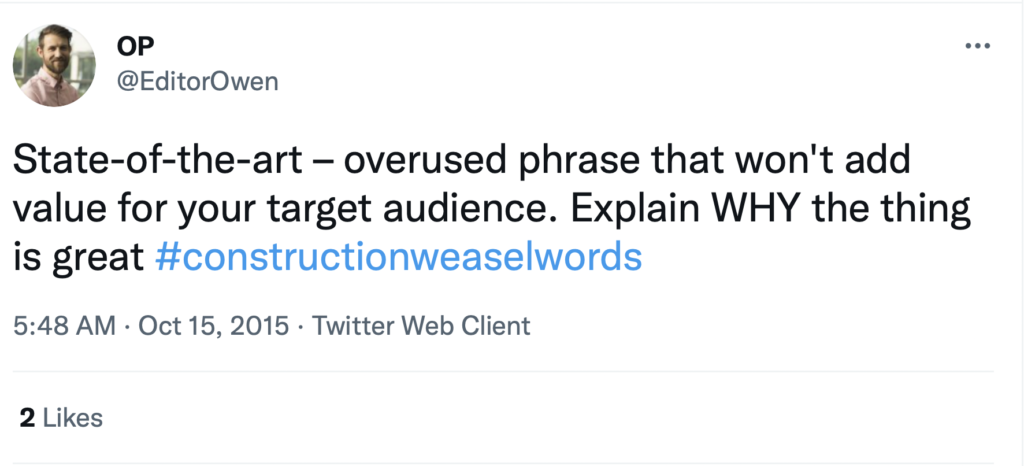Is academic jargon poisoning your communication with its miasma of unintelligible argle-bargle?
Let’s turn to Mark Twain for guidance. Though the beloved author of Huckleberry Finn lived long before the internet, his advice still rings true in the digital age:
According to Twain, the writer shall…
- Say what he is proposing to say, not merely come near it.
- Employ a simple and straightforward style.
- Eschew surplusage.
In other words, keep your communication simple, clear, and free of dreaded jargon.
What Is Academic Jargon?
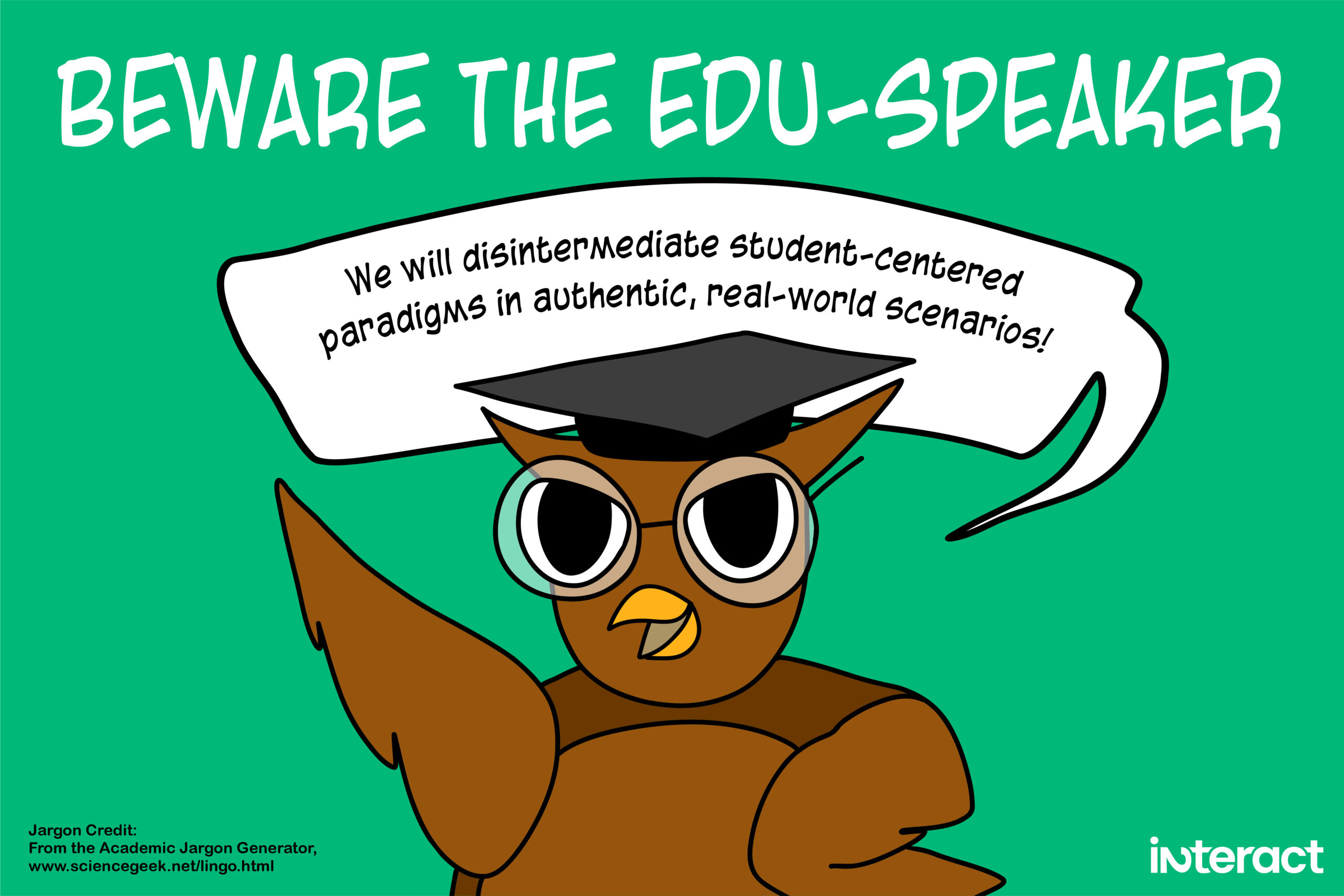
For a good laugh, try out the academic jargon generator!
Academic jargon, also known as edu-speak or edspeak, is the “internal-speak” higher ed employees often adopt. Most do not realize that students and families do not understand or even misunderstand this language.
At best, academic jargon is unnecessarily complicated language. At worst, it is perceived as wordy nonsense that creates frustration, distrust, and anger.
According to sociologist Martin Kozloff, edspeak is “unmatched twaddle. Unbelievable bilge. Absolutely staggering nonsense.”
Journalist Liz Willen, who has specialized in education news for more than 25 years, says that academic jargon “often wind[s] up sowing confusion or rendering important ideas incomprehensible.”
Academic Jargon Hits Historically Marginalized Students the Hardest
Community colleges are built to serve first-generation, English-as-a-second-language, and adult-ed students, among many others. Yet 50 percent of U.S. adults can’t read a book written at an eighth-grade level, according to the Organization for Economic Cooperation and Development.
Community colleges should be the inclusive institutions that help bridge this staggering gap. Yet when schools use needlessly complicated or confusing language, they end up alienating the very students that need their services the most.
Consider: A 2013 survey found that 70 percent of polled students were confused by the terminology on college websites.
Academic jargon can bewilder, isolate, and turn away potential students. When in doubt, cut that jargon out!
An Example: Don’t Use Academic Jargon with First-Generation Students
Just take Bunny. They are the first in their family to attend college, but they don’t know that’s exactly what “first-generation student” means:
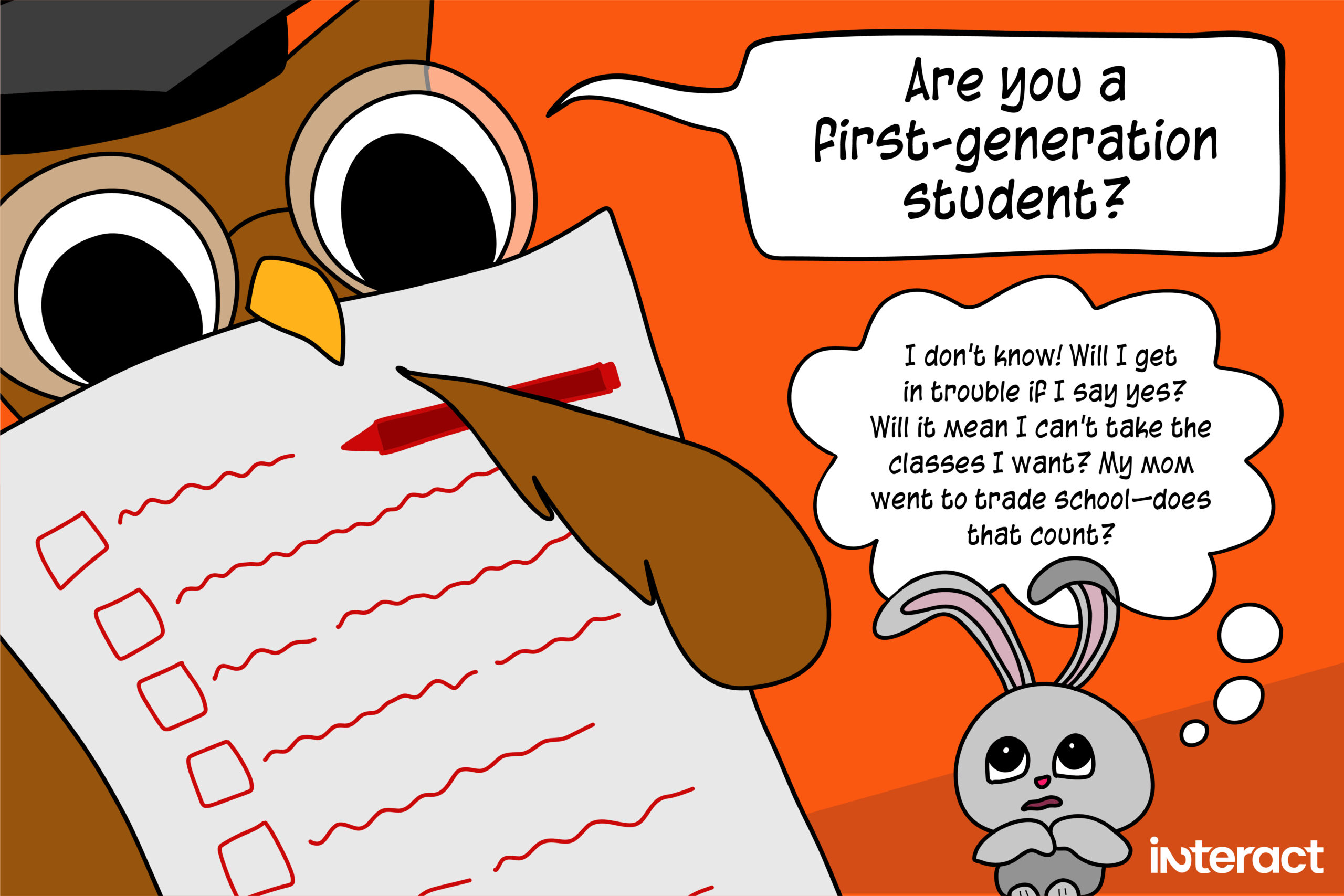
According to the Center for First-Generation Student Success, “While roughly fifty percent of students identify as first-gen, many are unaware of their first-gen status until they reach college, which can make accessing resources difficult.”
Academic jargon creates barriers. Your audience won’t understand your point and will likely disengage.
“Jargon-Monoxide”
As Kathy Klotz-Guest of marketing strategy powerhouse Convince & Convert explains, jargon is marketing pollution that she calls “Jargon-Monoxide Poisoning.”
Just as carbon monoxide pollutes the air, jargon monoxide poisons your message, destroys your clarity, and ruins your credibility.
Ouch. Ready to learn how to identify this noxious pest?
Eliminating Academic Jargon
In order to steer clear of jargon, we need to identify its many hydra heads.
Here are some of our favorite examples of edu-speak to ditch if you can, or define if you can’t:
- Matriculation
- No one knows what this word means—including your staff!
- Alternatives: Use enroll, sign up, or register.
- Bursar
- What’s the difference between the bursar’s office and financial aid? It turns out that most students don’t know!
- Solution: if you must use this word, always define it.
- CE (And Its Twin, CTE)
- According to our Chief Executive Officer Pam Cox-Otto, ”This one is crazy-making! In some systems, ‘CE’ stands for Career Education. In others, it’s ‘Continuing Education’ with a ‘U’ tacked on to identify ‘Continuing Education Units.’ In still others, ‘CE’ is ‘Community Education’ and is a whole range of free classes offered by the college!
“Holy cats, we need to start with a dictionary!”
Solution: Always spell out acronyms like CE, CEU, and CTE on first use, and be sure to define the terms.
This brings us to the next point…
When Acronyms Become Academic Jargon
Acronyms can be handy tools if you need a quick shorthand. But overuse them, and you can make your audience feel ignorant, overwhelmed, or excluded.
“My biggest pet peeve is the overuse of acronyms for departmental names that are read like a word,” says our VP Mary DeLuca. For example, does “CALC” stand for “Computer Assisted Learning Center,” or is it just short for “calculator”?
As our VP says, “Everyone outside of the institution is in the dark, not understanding what the acronym word means!”
Is your marketing material strewn with seemingly random sequences of letters? Can your audience tell STEM from a potted plant that’s lost its leaves?
”I do think colleges sometimes forget they’re talking to students, and the acronyms make it infinitely more difficult and intimidating for some to understand,” says Interact’s Executive Director of Media Prefs Jamie Wagner.
Perhaps English isn’t the student’s first language. Or, maybe they have linguistical challenges or other disabilities. It could also be that their internal self-criticism is telling them they’re not smart enough for college.
”When you’re in the higher ed world for a long time, jargon and acronyms become second nature in your vocabulary,” says Wagner. “It is always important to understand where speaking in these terms can be beneficial, like in an internal meeting with other higher ed folks. Or, when it could be harmful, like in new student communications.”
Just take poor Bunny, who just wants to register for classes:
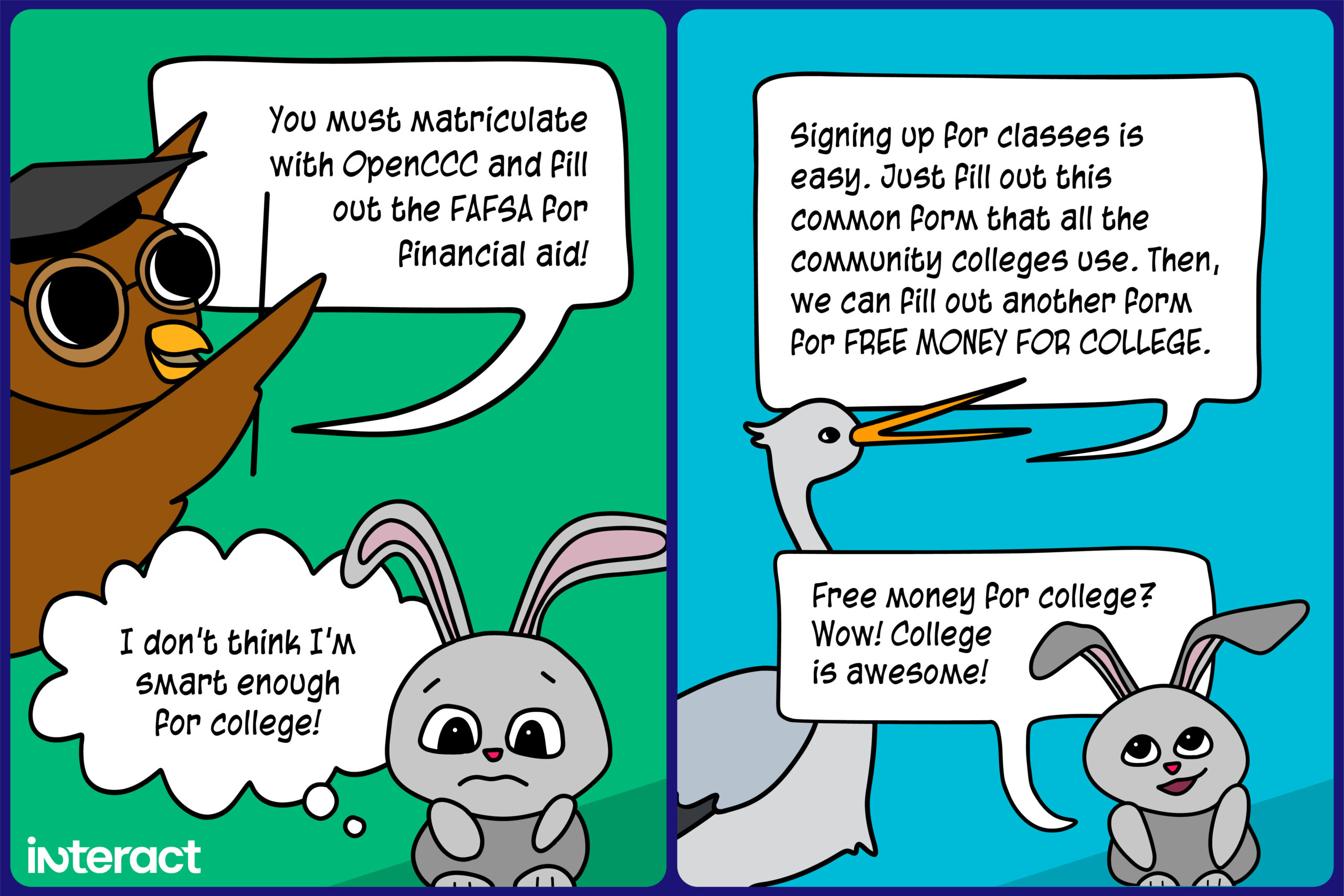
The lesson: Don’t fall back on acronyms when real words will communicate your message more clearly.
7 Simple Tips to Avoid Academic Jargon
1. Clarity
Don’t make students work overtime to understand your message. As Mark Twain said, keep it simple, short, and to the point.
According to Klotz-Guest, “Clarity is the communicator’s burden, and busy people won’t take the time to decode your message. They shouldn’t have to.”
Pro Tip: If you can, have someone outside of your organization read over your communication before you send it out.
Corral your student interns, ask your work-study employees, or let a coworker from another department read it over. Ask them if your language is relatable, easy to understand, and engaging.
2. Simplicity
To quote The Elements of Style by William Strunk Jr. and E. B. White: “Do not be tempted by a twenty-dollar word when there is a ten-center handy, ready and able.”
A ten-dollar word is one that is needlessly complicated, difficult, and even pretentious. A ten-cent word, on the other hand, is far from cheap. It’s as simple and useful as a dime.
Don’t use big words to sound important because it will likely backfire. Real experts know how to explain things simply, without confusing their audience. You’re not watering down your message — you’re making it more accessible.
To borrow one of my favorite quotes from the graphic design world:
“Design is so simple. That’s why it’s so complicated.”
This saying from Paul Rand, famous American graphic designer and proponent of the sleek Swiss Style, can and should be applied to writing.
Our job as communicators is to break down concepts so that our audience doesn’t have to work overtime. It takes hard work, but the results are worth it.
3. Ditch Cliches and Be Straightforward
Learn to weed out empty buzzwords and cliches from your writing and replace them with words that really say something.
According to The Muse, some of the most annoying buzzwords to eliminate include the following:
- Boots on the ground
- Move the needle
- Paradigm shift
- Toolkit
- Out of the box
- Synergy
Speaking of synergy… If you want an educational laugh, listen to Weird Al Yankovic’s song “Mission Statement.” It makes fun of empty, jargon-y words, and pretty much every chorus ends with “SYNERGY!”
Sing it with me now!
“We must all efficiently
Operationalize our strategies
Invest in world-class technology
And leverage our core competencies
In order to holistically administrate
Exceptional SYNERGY!“
4. Avoiding “State-of-the-Art” Cliches
“‘State-of-the-art’ is overused and essentially meaningless as everything is now ‘state-of-the-art,’” says our Vice President Mary DeLuca.
She’s not the only one who thinks so. Copywriter and marketer Owen Philipson agrees:
In fact, state-of-the-art ranks #21 as The Most Overused Buzzwords and Marketing Speak in Press Releases. (Ironically, “Outside of the Box” isn’t actually thinking outside of the box — it ranks at #89 for clichés to avoid!)
5. Make a “You-Turn”
A “you-turn” is when you take content that is all about your business and turn it around to make it all about YOU, the student.
Also called “outward-facing content” by those eggheads in the marketing field, taking a “you-turn” is part of a larger strategy when you start engaging directly with your audience, instead of just talking at them.
For example….
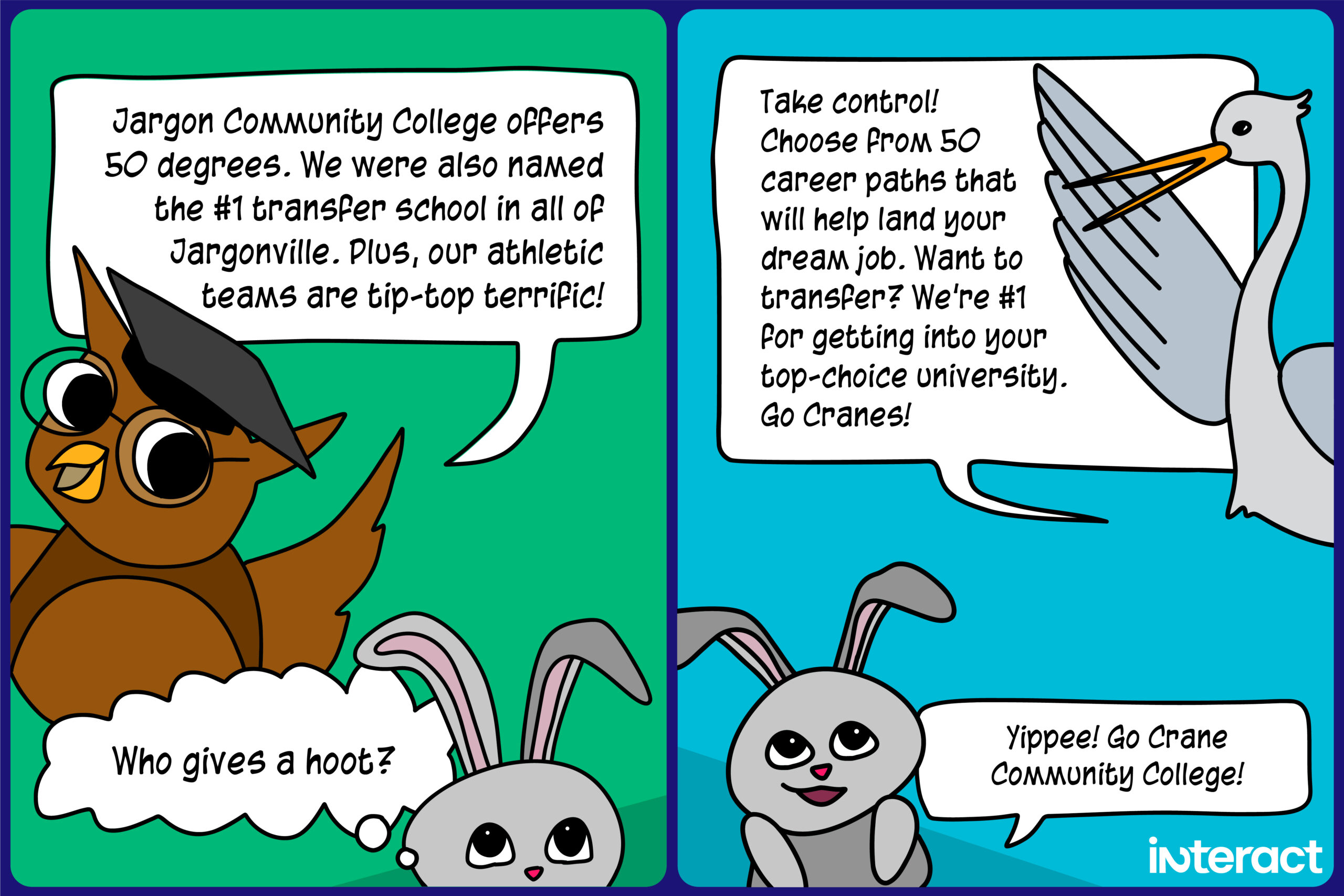
Keep your language simple and straightforward, and remember to make it meaningful and motivational as well!
6. Keep Content at a 6th-Grade Reading Level
Now, readability could be its own blog, but we’ll touch on it briefly. You can analyze your content to see what grade level you are writing at, which can help you determine if your audience can understand your message.
There are different measurements, including the Flesch-Kincaid test. You can put your content through an easy-to-use tool and find out how your content measures up.
Studies have shown that writing for a 6th-grade reading level increases the performance of online content by 25 percent.
Since 50 percent of the U.S. population reads at a lower literacy rate, writing at an 8th– or 9th-grade level could mean missing your audience. Even Google uses “ease of reading” as one of the factors in its ranking engine for ads.
My favorite tool to check readability is the Readable app, which has a free and paid version. Just create a free account, copy and paste your text into the editor, and you’ll be ready to become more readable.
Bonus: The app will also point out words longer than 12 letters, helping you to eliminate those 10-dollar words. Plus, it will also highlight cliches and hard-to-read sentences.
7. More Handy Tools to Avoid Academic Jargon
- As I mentioned above, the Readable app is fantastic and easy to use.
- Grammarly: In addition to correcting your grammar and finding those hidden spelling mistakes, the app will also point out words and phrases that should be simplified. It offers a free and paid version.
- The Hemmingway App is a terrific, free resource to simplify your writing and eliminate jargon. It’s a simple-to-use editor you can use in your browser, or you can download the desktop app for a small fee.
(Author’s note: I’m not affiliated with these services, and neither is Interact! I just really like them.)
Key Takeaways for Crushing Academic Jargon
- Academic jargon is the “internal-speak” higher ed employees use, which can confuse students and their families.
- Using jargon can hit historically marginalized students the hardest.
- Avoid using words like matriculation, bursar, and mysterious acronyms.
- Keep your writing clear, simple, and straightforward.
- Ditch empty buzzwords and cliches.
- Keep your content geared toward your audience.
- Aim for a 6th-grade reading level.
- Use handy tools like the Readable app and Grammarly to keep your writing simple, accessible, and jargon-free.

Do you have a favorite strategy for avoiding jargon? What about a pet peeve? Let us know!
Keep Reading!

